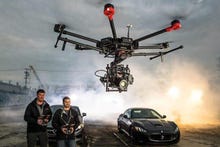Attack of the flying selfie sticks
Drones have long been one of those rare personal, portable kinds of devices that have seen great growth but have failed to cross over into a true consumer application. Quadcopters have proven themselves in fields such as real estate, agriculture, military and rescue operations, enthusiast and pro videography, and OK Go videos, and a few have been marketed as STEM or general toys. However, there's been little reason for the average person to have a drone. Like computers before the PC, the devices have been too large, too expensive, and too complex to appeal to the mass market. Today, one of the smallest and least expensive drones, the DJI Mini 2.
But in 2019, AirSelfie launched an Indiegogo campaign for a palm-sized, $150 drone focused on a single application: hovering in mid-air to snap a photo or quick video. Picking up (or taking off) from where the selfie stick left off, taking vanity photos with the bantam drone would be dead simple and allow for instant social media sharing. While still an order of magnitude more expensive than a typical selfie stick, its hands-free operation could capture images that couldn't be achieved with a stick-mounted smartphone. But after attracting nearly 7,000 backers and over $1.6 million, things went the way of many hardware crowdfunding campaigns — lengthy delays, some unfulfilled orders, and performance that wasn't as slick as promised. Now, AirSelfie is back with the Air Neo. It shoots 2K videos with a 12MP camera, looking much like the original.
The original AirSelfie drone has also clearly attracted the attention of “camera company” Snap, Inc., whose device market path has included a series of camera-enabled Spectacles. These have seen limited distribution and, more recently, a more limited audience as the social sharing company has pushed into augmented reality with the Spectacles 3. But unless you're one of the greenlit “creators looking to push the limits of immersive AR experiences,” they're not for sale. Sorry, Veruca.
Also: DJI Mavic 3: The very best drone
In contrast, while larger and more expensive than the Air Neo, Snap's Pixy drone starts at just $250. Continuing its collaboration with Qualcomm from the Spectacles 3, the Pixy includes an image sensing processor from the mobile processor giant. As you might expect, the Pixy automatically sends photos to SnapChat. But if you're not already part of Team Snap, it can also offload photos to a PC via USB. While the Pixy falls into an emerging device class just as easily as Spectacles, the mini-drone represents the company's strongest effort at a consumer device yet. For one, a simple web order form — as opposed to the appearance of an ephemeral vending machine — allows anyone to make a purchase.
Will we soon see our streets flooded with eye-level selfie-taking mini-drones? Would their potential annoyance to others be outweighed by allowing safer situational awareness? While more convenient and cooler (a low bar) than the selfie sticks of yore, we should recall that smartphone makers addressed the main reason for selfie-stick usage by broadening the field-of-view of their front-facing cameras. Nowadays, it's easier for group selfies or “ussies” to include three or four people. Beyond that, the participation of those with the largest humeri and the collective comfort level with personal space violation become limiting factors. If the Air Neo and Pixy can win and find a market among those looking to eek out a bit more creativity and flexibility in their social presence and thus capture a significant fraction of the market that once existed for selfie sticks, that would represent a great leap forward for consumer drone applications.




